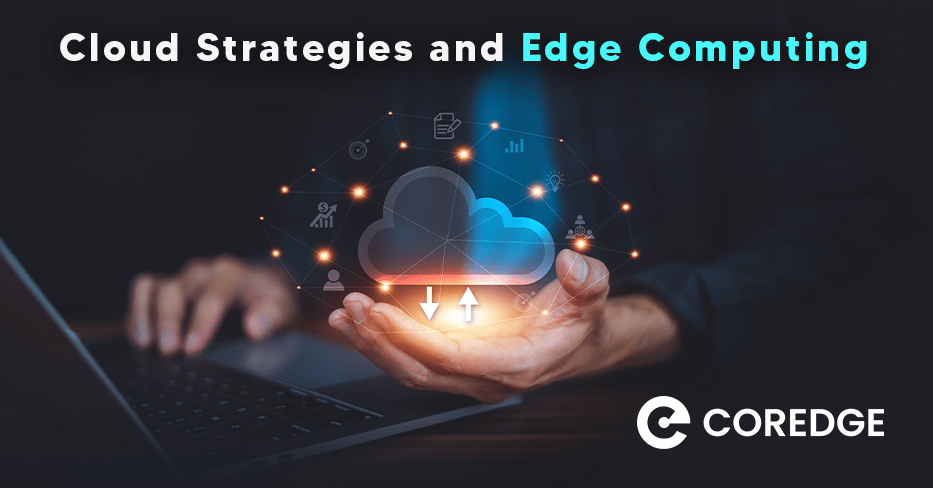Multi-cloud Orchestration with CloudCompass
Coredge Marketing
October 07, 2022

The pandemic led to an increase in remote work and e-commerce, and businesses have been increasingly shifting data, applications, and development work to the cloud. This trend has witnessed a considerable boost. Cloud computing continues to have a significant impact on both business and IT. The cloud has changed how businesses and IT interact, altering business models, expediting the delivery of new business services, developing new frameworks for consumer engagement, and enhancing staff productivity.
However, a turning point has occurred in the cloud market. Organizations use both innovative cloud microservices and dated monolithic software, numbering in the hundreds or even thousands. They are all unique. But they are also essential to their company. Traditional app architectures are being replaced by new cloud-native approaches. Datacenter, cloud, and edge industries are integrating. Furthermore, multi-cloud diversity, which was long thought to be chaotic and difficult, is now recognized as the most potent source of innovation. In past, we already discussed What is Multicloud Orchestration? Why Do We Need It? – coredge.io. Let us dive deep and understand more aspects of Multi-cloud.
Kubernetes offers the best multi-cloud platform: Kubernetes offers the ability to orchestrate containers and makes it simple to encapsulate applications. The Kubernetes management system offers a standardized method for delivering applications that is independent of the underlying infrastructure and is cloud-agnostic.
You can successfully manage your multi-cloud infrastructure with the assistance of Kubernetes. Having said that, there are some of the most common challenges you might experience are discussed below
You can successfully manage your multi-cloud infrastructure with the assistance of Kubernetes. Here, some of the most common challenges you might experience are discussed.
Increased complexity
The added complexity of multi-cloud computing may be one of its hidden costs. Every cloud service has its own customs, instructions, and methods of operation. For instance, GCP has six different types of load balancers compared to AWS’s three, each of which handles a different component of load balancing. Others operate at Layer 4, while some at Layer 7. The embedded firewall in one of the GCP products requires special management. Given the variety of options, choosing how to load balance and secure your application on one cloud is difficult enough. Trying to do this across many clouds adds more complexity. If you spread this complexity over several services, your company could become quickly overburdened.Disparities Among Clouds in Service Capabilities
: Some clouds are superior to others for certain purposes. In essential services like computation, storage, and networking, different clouds have vastly diverse capabilities at a more granular level. For instance, Kubernetes should be maintained uniformly across all clouds, according to theory. Each major cloud provider manages Kubernetes differently in practice, as do the monitoring and security tools for these managed offerings and the performance standards. As a result, even though a service appears to be identical and is based on the same fundamental technology, significant changes may affect performance, resilience, and how an application is constructed.Cost Management
: Over time, it has become more and more difficult to comprehend and control cloud provider pricing. Computing, storage, networking, memory type (SSD versus spinning disc), region or zone, data transit, and request volume are all factors that cloud providers charge for. Consider load balancing alone for a moment. Most cloud service providers charge for the size of the load balancer instance as well as its kind (spot or reserved), the number of requests it can handle per server per second, whether it is moving data within a region or across regions, and the number of rules it may use to do so. Charges for each of these components differ from cloud to cloud, and even the definitions of the services are not entirely consistent. For instance, GCP offers several networking tiers, whereas Azure does none. Cost management and forecasting in a single cloud are difficult but are frequently better addressed by the management and projection tools of the providers. All of this fails between clouds, especially if you frequently move your application architecture, data, or any other piece between clouds to take advantage of price arbitrage opportunities.Slower Time-To-Market on Application Changes
: Because you must carefully test the changes in each cloud environment, deploying an application across several clouds might delay the release of new features and functionality. The deployment of comparable applications running in containers should theoretically reduce this risk at each tier. Even containerized applications run differently on various clouds in real life. You need to plan time for testing and anticipate additional work for capabilities and apps that are mission-critical.Raising Security Risk and Attack Surface
Security risk may rise with growing complexity. Your security team will need to monitor twice as many or three times as many services that are active across several clouds in a multi-cloud environment. As a result, it is simpler for attackers to conceal their actions and avoid detection. Additionally, security teams must configure and test 2 or 3 times as many security tools and appliances. The already overworked security personnel are put under a lot more stress as a result of this, and there is a higher chance that a misconfiguration or a missed update would lead to a human mistake. When working with many clouds, DevOps teams may become upset by the complexity and come up with workarounds that widen the attack surface and raise the risk. Furthermore, data movement between clouds increases exposure and the attack surface.Ignores Best-of-Breed Lock-in
Lock-in risk is addressed if you approach multi-cloud as a genuine N+1 solution with fully independent application replicates running across several clouds. However, for certain areas of cloud computing, many businesses use a best-of-breed approach. For example, they might use GCP as their main computing cloud for ML applications or AWS as their main data repository. Even worse things are possible. You may have two teams operating their ML operations: one on Azure and one on GCP. Fragmenting lock-in at the service level covers it up.
How Kubernetes can help reduce Multicloud issues
You can successfully manage your multi-cloud infrastructures with the assistance of Kubernetes. Here, some of the most common difficulties you might experience are discussed.
Setting Up Multi-cloud Systems
In a multi-cloud system, provisioning resources can be difficult because there is usually not a single tool you can use. To assist you in automating the process within their cloud, public cloud suppliers frequently make their proprietary tools available. But often, you can only utilize these tools with the particular tool provider. As an alternative, you can utilize provisioning tools from a third party, such as Terraform or Ansible. These frequently need manual adjustments for every cloud provider, though. Workloads hosted by Kubernetes, on the other hand, are consistent across cloud providers. Because of this, you can utilize the same setup on any host. You also gain from continuous speed and Kubernetes-driven automation during the provisioning process because Kubernetes configurations are expressed as code.Monitoring Multi-cloud
You must figure out how to include the monitoring capabilities of several suppliers in a multi-cloud. This is valid even if you employ application performance management (APM) technologies from outside sources. In contrast, you can concentrate your efforts on monitoring Kubernetes when all of your workloads are run through it. Since the platform already provides readily-accessible metrics for the majority of your monitoring needs, this is a rather simple process.Security
In comparison to a single cloud, a multi-cloud system presents a bigger attack surface and more setup error potential. While Kubernetes cannot eliminate the need to verify that your host resources are secure, it can make application security simpler. It accomplishes this by unifying your setups and providing visibility across all of your workloads. Additionally, Kubernetes provides access to native features that increase the functionality of your security toolkit. These attributes consist of network policies, pod security rules, and role-based access control (RBAC).Cost Control
Although multi-cloud can save you prices, it also gives you more chances to incur charges. However, Kubernetes resource utilization is typically simpler to manage and control. It is debatable whether the same is true of Kubernetes. Resource waste and omission, both of which drive up expenses, can be prevented with the use of standard, automated supply. The cost is frequently more transparent when using a managed Kubernetes solution as opposed to that of cloud vendors.
How CloudCompass can be used as a Multi-cloud orchestrator
The Coredge CloudCompass platform delivers data governance and end-to-end performance monitoring using the Coredge Guardian product, which is integrated into the platform and controls the complexity of the cloud infrastructure through automation and the unification of the OSS, security, and orchestration.
CloudCompass is a cutting-edge unified Kubernetes and OpenStack management platform for distributed clouds. Its distinct management plane offers centralized management and automation for distributed Kubernetes clusters, removing complexity and reducing expenses. CloudCompass manages large-scale management of containers, VMs, and bare metal on any customer infrastructure at any location.
CloudCompass offers a public cloud experience on any infrastructure from the data center to the edge, removing the complexity of infrastructure and operations and offering a single, unified cloud experience for fully portable applications and DevOps, a single control plane, and automated full-stack lifecycle management with continuous updates. In addition, CloudCompass specializes in cloud service architecture, engineering, delivery, management, and maintenance for a wide range of providers, data centers, governments, telcos, and business clients. We are the ideal business partner to help your business grow! Connect with us or mail us at talktous@coredge.io to know more about CloudCompass and its exclusive features.





